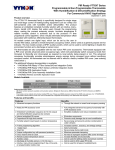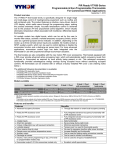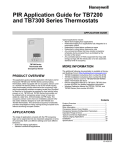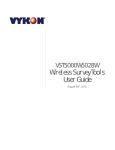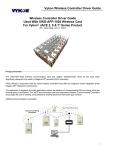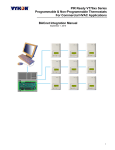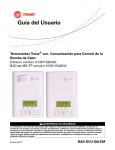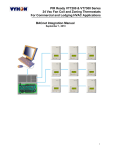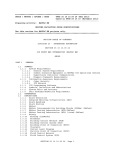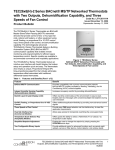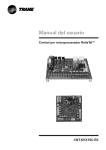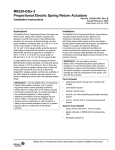Download Vykon VT76X7 Installation guide
Transcript
PIR Application Guide for the for VT7xxxX5028(X) Series thermostats1 September 1, 2010 Product Overview The VI-PIR Accessory covers with embedded Passive Infra-Red motion detector have been specifically designed to work with all compatible VT7000 series thermostats. Thermostats compatible with VI-PIR covers use the following part number assignments: VT7xxxxX5xxx(X). The 5 identifies the thermostat base thermostat has the necessary onboard polarized PIR connector and functionality added. When equipped with a VI-PIR accessory cover or a remote PIR sensor attached to one of the remote input, a VT7000 series thermostat provides advanced active occupancy logic, which will automatically switches occupancy levels from Occupied to Stand-By and Unoccupied as required by local activity being present or not. This advanced occupancy functionality provides advantageous energy savings during occupied hours without sacrificing occupant comfort. The range of applications covered with the PIR occupancy logic van be segmented in 2 important categories in terms of functionality. Both use different settings and have different behaviours: • Hotel and lodging applications • Standard commercial applications Typical applications that can be meet by the new PIR accessory covers range from: • Stand-alone lodging FCU applications • Networks lodging FCU applications fully integrated to a reservation system • Networked or stand-alone conference rooms • Networked or stand-alone classrooms units • Any commercial offices that have random occupancy schedules during occupied hours as dictated by the function of the tenant • Or any controlled piece of HVAC equipment that may yield energy savings with the introduction of a new automatic stand-by level of occupancy. The additional following documentation is available: • VYKONStat PIR Ready VT7200 Series Thermostat Installation Guide • VYKONStat PIR Ready VT3000 Series Thermostat Installation Guide • VYKONStat PIR Ready VT7600 Series Thermostat Installation Guide • VYKONStat PIR Ready VT76x7 Series Thermostat Installation Guide • VYKONStat PIR Cover Assembly Installation Guide VI- PIR Cover Models Available Vykon PIR Cover Part Number Description Compatible with the Following Thermostats COV-PIR-FCU-C-5028 PIR cover with Commercial FCU interface VT73x0X50xx(X) COV-PIR-FCU-L-5028 PIR cover with Hotel/Lodging interface VT73x5X50xx(X) COV-PIR-HPUMP-5028 PIR cover for heat pump thermostats VT76xxH50xx(X)x COV-PIR-RTU-5028 PIR cover for roof-top thermostats VT76xxX50xx(X) COV-PIR-ZN-5028 PIR cover for zoning thermostats VT7200X50xx(X) 10/16/07 028-xxxx PIR Application Guide-E00.doc www.Vykon.com [email protected] Configuration Parameters Associated with the Vykon PIR Accessory Covers The following configuration parameters are specifically provided as standard on all VT7000 series thermostats. They are associated with the advanced occupancy functionality introduced with the addition of a PIR cover or a remote PIR sensor. These parameters will allow the installer to set the thermostat occupancy functions exactly as required by the application. Their functionality only becomes active if a PIR accessory cover is connected or one of the binary/digital input is configured to use a remote PIR sensing device. Configuration Parameter Description of Configuration parameter BI or DI input door setting It is possible to configure some of the digital or binary inputs to effectively use the advanced functions allowed by the installation of a door switch contact. This function is mostly used with fan coil units in lodging applications Default: None for no function used Stand-by Heating Set point: Default: 69 °F ( 20.5 °C ) When a door contact is used and configured, the Stand-By timer is no longer active. The occupancy toggle between occupied and stand-by is now dictated by both the door contact and the PIR cover. • Movement detected by the PIR cover = Always occupied • Door opens / closes detected by the door switch = Stand-by mode This parameter sets the stand-by heating setpoint value. The set value of this parameter should reside between the occupied and unoccupied heating setpoints and make sure that the difference between the stand-by and occupied value can be recovered in a timely fashion when movement is detected in the zone. Adjustable from 40 to 90 °F ( 4.5 to 32 °C ) in 0.5 degree increments. This parameter sets the stand-by cooling setpoint value. Stand-by Cooling Set point: Default: 78 °F ( 25.5 °C ) The set value of this parameter should reside between the occupied and unoccupied cooling setpoints and make sure that the difference between the stand-by and occupied value can be recovered in a timely fashion when movement is detected in the zone. Stand-by Time: Adjustable from 54 to 100 °F ( 12.2 to 37.8 °C ) in 0.5 degree increments. This parameter sets the time delay between the moment where the PIR cover detected the last movement in the area and the time which the thermostat stand-by mode and setpoints become active. Default 0.5 hours Adjustable from 0.5 to 24 hours in .5hr increments Unoccupied Time: If no movement are detected in the area and the current mode is stand-by. This parameter will then set the time delay between the moment where the thermostat toggles to stand-by mode and the time which the thermostat unoccupied mode and setpoints become active. Default 0.0 hours The factory value or 0.0 hours: Setting this parameter to its default value of 0.0 hours disables the unoccupied timer. This prevents the thermostat to drift from stand-by mode to unoccupied mode when PIR functions are used Adjustable from 0.0 to 24 hours in .5hr increments 2 3 Important Notes and Things to Know When reviewing the following document and planning an application using a Vykon thermostat with PIR functionality, please remember the important following notes: • Configuration of PIR Functions: All PIR application related configuration parameters are displayed in the configuration menu or available as objects in the network object list. However, the advanced occupancy functionality of a PIR attached to a thermostat is only enabled if either: - A Vykon VI-PIR cover is installed on the thermostat - A remote input is configured as a remote PIR sensor ( Motion NO or Motion NC ) • PIR Cover Warm-Up Period: When VI-PIR accessory cover is used and a thermostat is powered up; there will be a 1 minute warm up period before any local movements can being detected and acknowledged by the PIR sensing device. The local status LEDs for the VI-PIR cover will also not be active during that one minute period. Only when that 1 minute period has elapsed after initial power up of the thermostat will the PIR functionality and local movement status LEDs be activated. • Setpoints: The implemented stand-by setpoints are under the same limitations and restrictions as the occupied and unoccupied ones. This means that: - They use exactly the same range: • Heating setpoints range are: 40 to 90 °F ( 4.5 to 32.0 °C ) • Cooling setpoints range are: 54 to 100 °F ( 12.0 to 37.5 °C ) - They are always limited by the applied minimum deadband configuration - They will be limited by the Heat Maximum and Cool Minimum configuration parameters All individual cooling setpoints and all individual heating setpoints can be set independently. However, A typical arrangement will always have the set value of the stand-by parameters residing between the corresponding occupied and unoccupied setpoint values. The installer must make sure that the difference between the stand-by and occupied value can be recovered in a timely fashion when movement is detected in the zone and large enough to warrant maximum energy savings. Ex.: Deadband Unocc Heat = 65F St-By Heat = 69F Occ Heat = 72F Occ Cool = 75F St-By Cool = 78F Unocc Cool = 82F Room Temperature • Application Range: The range of applications covered with the PIR occupancy logic van be segmented in 2 important categories in terms of functionality. Both use different settings and have different behaviours: - Hotel and lodging applications - Standard commercial applications Hotel and Lodging Applications can benefit the addition of an entry door switch wired to one of the appropriately configured remote input of a thermostat. When a door contact is used and configured, the Stand-By timer and its configuration are no longer active or used. The occupancy front toggle between occupied and stand-by is now simply dictated by both the door contact and the PIR sensing device used. If movements are detected by the PIR cover, the room will always be occupied. The switch back to stand-by mode will only happen if the door switch toggles open / close. Please review attached lodging application examples in the document for more information Standard Commercial Applications would not typically use a remote door switch contact attached to the thermostat. PIR occupancy functionality is simply dictated by both the Stand-By Timer and Unoccupied Timer configuration value and movements being present or not in the area. Please review attached typical commercial application examples in the document for more information • Unoccupied Timer Disable: In certain application cases, it may be desired to never let the local area enter the unoccupied mode and always stay at the stand-by occupancy level when no activity is present. 4 This allows for advanced flexibility when used in conjunction with a network or in cases when areas always need to be on stand-by status ready to respond to demand at any point in time. Unoccupied timer set 6 Hours and stand-by timer set to 2 hours Occupied Stand-By Time = 2 Hours Stand-By Time = 2 Hours Stand-By Unoccupied Time = 6 Hours Unoccupied Time = 6 Hours Unoccupîed Time Time Last Movement Detected by PIR Activity Stand-By Time Elapsed = Stand-By Mode Unoccupied Time Elapsed = Unoccupied Mode Stand-By Time Elapsed = Stand-By Mode Last Movement Detected by PIR Activity When the local PIR occupancy routine is running at the thermostat, the zone will drift into unoccupied mode when the unoccupied timer is set above its factory default value of 0.0 hours Unoccupied timer set 0 Hours and stand-by timer set to 2 hours Occupied Stand-By Time = 2 Hours Stand-By Time = 2 Hours Stand-By Unoccupied Time = 0 Hours Unoccupied Time = 0 Hours Unoccupîed Time Time Last Movement Detected by PIR Activity Stand-By Time Elapsed = Stand-By Mode Last Movement Detected by PIR Activity Stand-By Time Elapsed = Stand-By Mode When the local PIR occupancy routine is running at the thermostat, the zone will never drift into unoccupied mode when the unoccupied timer is set to its factory default value of 0.0 hours • Network Priority and Local Occupancy Routine: The internal PIR occupancy logic implementation in conjunction with network commands has been conceived to give the most flexibility while allowing for simple implementation and use. Network Occupancy Commands: All VT700 series thermostat have 3 occupancy command levels. This is valid for all network variations available for the thermostats: LON, BACnet-MS-TP or Wireless. The 3 levels occupancy state level commands are: State Occupancy Function Command Levels Local occupancy - Releases the thermostat to its own occupancy schemes - This may be a PIR sensing device, a local schedule or an occupancy routine done by one of the digital input - This state command level is used to effectively release the thermostat to use the PIR functions Occupied - Leaves the thermostat in occupied mode and cancels any local occupancy functions, including the PIR occupancy routine - This state command level is used to force the zone to be always occupied Unoccupied - Leaves the thermostat in unoccupied mode and cancels any local occupancy functions, including the PIR occupancy routine - This state command level is used to force the zone to be always unoccupied. - The only local possible command is a local override if the thermostat is equipped with such an option or if the local keypad lockout allows so Stand-by is never a commandable level. It only exists as a feedback status level. 5 Network Occupancy Feedback Status: All VT700 series thermostats have 4 occupancy feedback levels. This is valid for all network variations available for the thermostats: LON, BACnet-MS-TP or Wireless. State Occupancy Command Levels Override / By-Pass Occupied Stand-By Unoccupied Function Indicates that the zone is currently local occupied override mode from the unoccupied state This function will operate like a normal local override and its time value is as dictated by the ToccTime configuration parameter setting Indicates that the zone is currently occupied This effective feedback state may be driven by a local occupancy routine like a PIR sensor or by an occupied network command Indicates that the zone is currently in stand-by mode This effective feedback state can only be driven by a local PIR occupancy routine Indicates that the zone is currently unoccupied This effective feedback state may be driven by a local occupancy routine like a PIR sensor or by an unoccupied network command 1) BACnet Object Used for Occupancy Commands and Feedback Object Name Object ID Occupancy Command MV 13 Effective Occupancy MV 83 BACnet Index Text 1 2 3 1 2 3 4 Local Occupancy ( PIR or Internal Schedule ) Occupied Unoccupied Occupied Unoccupied Temporary Occupied Stand-By 2) LON Snivets Used for Occupancy Commands and Feedback Snivet Name network input SNVT_occupancy nviOccCmd network output SNVT_occupancy nvoEffectOccup Notes and Indexes ¾ Default Null Value: OC_NUL = 0xFF Releases the thermostat to its internal Occupancy function: Internal scheduling, PIR, etc…. ¾ Valid Range: 0 = OC_OCCUPIED 1 = OC_UNOCCUPIED 2 = OC_BYPASS – Not Used 3 = OC_STANDY – Not Used 0xFF = OC_NUL (Release to PIR or internal schedule) ¾ This output network variable is used to indicate the actual occupancy mode of the unit. This information is typically reported to a supervisory controller or provided to another Space Comfort Controller to coordinate the operation of multiple units ¾ Valid Range: 0 = OC_OCCUPIED 1 = OC_UNOCCUPIED 2 = OC_BYPASS1 3 = OC_STANDBY Note 1: OC_BYPASS can be initiated by local override. NvoEffectOccup will only be in OC_BYPASS for the duration of the ToccTime (nciGenOpts), until reinitiated by either a transition of the local input or an update to nviOccManCmd. • Initial State, PIR Occupancy Routine: The initial effective occupancy state on power-up with either a PIR cover is 6 present or one of the inputs is configured for a remote PIR sensor is always: o In stand-alone applications at power-up: Local occupancy mode = Stand-by o From a previous network unoccupied command: Local occupancy mode = Stand-by o From a previous network occupied command: Local occupancy mode = Occupied. When the network effectively releases a thermostat to its local PIR routine from a previous occupied or unoccupied network state, the resulting occupancy state is always Stand-By mode. Initial Power-Up, Stand-Alone or Networked Occupied Stand-By Time = 2 Hours Stand-By Unoccupied Time = 6 Hours Unoccupîed Time Initial State at Power-Up = Stand-By First Movement Detected by the PIR Cover Unoccupied Time Elapsed = Unoccupied Mode Stand-By Time Elapsed = Stand-By Mode After Receiving the Local Occupancy / PIR Network Command From a Previous Unoccupied State Occupied Stand-By Time = 2 Hours Stand-By Unoccupied Time = 6 Hours Unoccupîed Time Current Network Command = Unoccupied Stand-By Time Elapsed = Stand-By Mode Initial State at Local Occupancy Network Command = Stand-By Unoccupied Time Elapsed = Unoccupied Mode First Movement Detected by the PIR Cover After Receiving the Local Occupancy / PIR Network Command From a Previous Occupied State Occupied Stand-By Time = 2 Hours Stand-By Time = 2 Hours Stand-By Unoccupied Time = 4 Hours Unoccupîed Current Network Command = Occupied Stand-By Time Elapsed = Stand-By Mode Initial State at Local Occupancy Network Command = Occupied Time Stand-By Time Elapsed = Stand-By Mode First Movement Detected by the PIR Cover Unoccupied Time Elapsed = Unoccupied Mode 7 Typical Commercial Applications+ Commercial Applications Application Number 1 2 3 4 5 6 7 8 9 10 11 12 PIR Levels of Occupancy 3 2 3 2 3 2 3 2 3 2 3 2 PIR Cover Used Yes Yes No No Yes Yes Yes Yes No No Yes Yes Remote PIR used No No Yes Yes Yes Yes No No Yes Yes Yes Yes PIR Cover Used Yes Yes No No Yes Yes Yes Yes No No Yes Yes Remote PIR used No No Yes Yes Yes Yes No No Yes Yes Yes Yes Network interface None, stand-alone None, stand-alone None, stand-alone None, stand-alone None, stand-alone None, stand-alone Yes, LON or BACnet Yes, LON or BACnet Yes, LON or BACnet Yes, LON or BACnet Yes, LON or BACnet Yes, LON or BACnet Lodging Applications Application Number 13 14 15 16 17 18 19 20 21 22 23 24 PIR Levels of Occupancy 3 2 3 2 3 2 3 2 3 2 3 2 Network interface None, stand-alone None, stand-alone None, stand-alone None, stand-alone None, stand-alone None, stand-alone Yes, LON or BACnet Yes, LON or BACnet Yes, LON or BACnet Yes, LON or BACnet Yes, LON or BACnet Yes, LON or BACnet Advanced network interface can be obtained when thermostats are fully integrated to the reservation system In these cases, the occupancy network commands state enumerations text presented by a front end system can be expanded to better represent the nature of the application. Occupancy network commands state Local Occupancy ( PIR active ) Occupied Unoccupied Front end system state text examples Room rented PIR economy enabled Room rented high comfort assured Room not rented • 1) VT7300 Stand-alone fan coil application using 3 levels of occupancy with a VI-PIR accessory cover Set-up and Configuration Thermostat used PIR used BI2 Configuration Stand-by timer value Unoccupied timer value Network interface used VT73x0X5028 ( commercial models ) COV-PIR-FCU-C-5028 accessory cover None, no function 2.0 hours 6.0 hours None, stand-alone Sequence of operation: Occupied Stand-By Time = 2 Hours Stand-By Unoccupied Time = 6 Hours Unoccupîed Time Initial State at Power-Up = Stand-By First Movement Detected by the PIR Cover Stand-By Time Elapsed = Stand-By Mode Unoccupied Time Elapsed = Unoccupied Mode At initial power-up, when the thermostat 24 Vac power supply is applied; the initial occupancy of the zone will be stand-by mode if the PIR device do not detect any movements. As soon as the PIR device detects a movement or motion, the occupancy status switches to occupied and the occupied setpoints are used. Anytime the PIR device detects local motion, the elapsed stand-by timer value will be reset. If no motion is detected in the zone for the entire stand-by timer duration, then the room switches to stand-by mode and the stand-by setpoints are used. While in stand-by mode, if no motion is detected in the zone for the entire unoccupied timer duration, then the room switches to unoccupied mode and the unoccupied setpoints are used. At anytime, if the PIR device detects a local movement or motion, the occupancy status switches to occupied and the occupied setpoints are used. • 2) VT7300 Stand-alone fan coil application using 2 levels of occupancy with a VI-PIR accessory cover Set-up and Configuration Thermostat used PIR used BI2 Configuration Stand-by timer value Unoccupied timer value Network interface used VT73x0X5028 ( commercial models ) COV-PIR-FCU-C-5028 accessory cover None, no function 2.0 hours 0.0 hours None, stand-alone Sequence of operation: Occupied Stand-By Time = 2 Hours Stand-By Time = 2 Hours Stand-By Unoccupied Time = 0 Hours Unoccupied Time = 0 Hours Unoccupîed Time Time Initial State at Power-Up = Stand-By First Movement Detected by the PIR Cover Stand-By Time Elapsed = Stand-By Mode Last Movement Detected by PIR Activity Stand-By Time Elapsed = Stand-By Mode At initial power-up, when the thermostat 24 Vac power supply is applied; the initial occupancy of the zone will be stand-by mode if the PIR device do not detect any movements. As soon as the PIR device detects a movement or motion, the occupancy status switches to occupied and the occupied setpoints are used. Anytime the PIR device detects local motion, the elapsed stand-by timer value will be reset. If no motion is detected in the zone for the entire stand-by timer duration, then the room switches to stand-by mode and the stand-by setpoints are used. At anytime, if the PIR device detects a local movement or motion, the occupancy status switches to occupied and the occupied setpoints are used. The local zone never goes into unoccupied mode and the unoccupied setpoints are never used. 8 • 9 3) VT7300 Stand-alone fan coil application using 3 levels of occupancy with a remote PIR sensor Set-up and Configuration Thermostat used PIR used BI2 Configuration Stand-by timer value Unoccupied timer value Network interface used Remote PIR Sensor VT73x0X5028 ( commercial models ) BI1 configured for remote PIR sensor None, no function 2.0 hours 6.0 hours None, stand-alone Sequence of operation: Occupied Stand-By Time = 2 Hours Stand-By Unoccupied Time = 6 Hours Unoccupîed Time Initial State at Power-Up = Stand-By First Movement Detected by a PIR Device Unoccupied Time Elapsed = Unoccupied Mode Stand-By Time Elapsed = Stand-By Mode At initial power-up, when the thermostat 24 Vac power supply is applied; the initial occupancy of the zone will be stand-by mode if the PIR device do not detect any movements. As soon as the PIR device detects a movement or motion, the occupancy status switches to occupied and the occupied setpoints are used. Anytime the PIR device detects local motion, the elapsed stand-by timer value will be reset. If no motion is detected in the zone for the entire stand-by timer duration, then the room switches to stand-by mode and the stand-by setpoints are used. While in stand-by mode, if no motion is detected in the zone for the entire unoccupied timer duration, then the room switches to unoccupied mode and the unoccupied setpoints are used. At anytime, if the PIR device detects a local movement or motion, the occupancy status switches to occupied and the occupied setpoints are used. • 4) VT7300 Stand-alone fan coil application using 2 levels of occupancy with a remote PIR sensor Remote PIR Sensor Set-up and Configuration Thermostat used PIR used BI2 Configuration Stand-by timer value Unoccupied timer value Network interface used VT73x0X5028 ( commercial models ) BI1 configured for remote PIR sensor None, no function 2.0 hours 0.0 hours None, stand-alone Sequence of operation: Occupied Stand-By Time = 2 Hours Stand-By Time = 2 Hours Stand-By Unoccupied Time = 0 Hours Unoccupied Time = 0 Hours Unoccupîed Time Time Initial State at Power-Up = Stand-By First Movement Detected by a PIR Device Stand-By Time Elapsed = Stand-By Mode Last Movement Detected by PIR Activity Stand-By Time Elapsed = Stand-By Mode At initial power-up, when the thermostat 24 Vac power supply is applied; the initial occupancy of the zone will be stand-by mode if the PIR device do not detect any movements. As soon as the PIR device detects a movement or motion, the occupancy status switches to occupied and the occupied setpoints are used. Anytime the PIR device detects local motion, the elapsed stand-by timer value will be reset. If no motion is detected in the zone for the entire stand-by timer duration, then the room switches to stand-by mode and the stand-by setpoints are used. At anytime, if the PIR device detects a local movement or motion, the occupancy status switches to occupied and the occupied setpoints are used. The local zone never goes into unoccupied mode and the unoccupied setpoints are never used. • 10 5) VT7300 Stand-alone fan coil application using 3 levels of occupancy with dual PIR sensors Remote PIR Sensor Set-up and Configuration Thermostat used PIR used VT73x0X5028 ( commercial models ) BI1 configured for remote PIR sensor and COV-PIR-FCU-C-5028 accessory cover None, no function 2.0 hours 6.0 hours None, stand-alone BI2 Configuration Stand-by timer value Unoccupied timer value Network interface used Sequence of operation: Occupied Stand-By Time = 2 Hours Stand-By Unoccupied Time = 6 Hours Unoccupîed Time Initial State at Power-Up = Stand-By First Movement Detected by a PIR Device Unoccupied Time Elapsed = Unoccupied Mode Stand-By Time Elapsed = Stand-By Mode At initial power-up, when the thermostat 24 Vac power supply is applied; the initial occupancy of the zone will be stand-by mode if the PIR devices do not detect any movements. As soon as any of the PIR device detect a movement or motion, the occupancy status switches to occupied and the occupied setpoints are used. Anytime local motion is detected by one of the PIR devices, the elapsed stand-by timer value will be reset. If either PIR devices in the zone detect no motion for the entire stand-by timer duration, then the room switches to stand-by mode and the stand-by setpoints are used. While in stand-by mode, if no motion is detected in the zone by either PIR devices for the entire unoccupied timer duration, then the room switches to unoccupied mode and the unoccupied setpoints are used. At anytime, if one of the PIR device detects a local movement or motion, the occupancy status switches to occupied and the occupied setpoints are used. • 6) VT7300 Stand-alone fan coil application using 2 levels of occupancy with dual PIR sensors Set-up and Configuration Thermostat used PIR used Remote PIR Sensor VT73x0X5028 ( commercial models ) BI1 configured for remote PIR sensor and COV-PIR-FCU-C-5028 accessory cover None, no function 2.0 hours 0.0 hours None, stand-alone BI2 Configuration Stand-by timer value Unoccupied timer value Network interface used Sequence of operation: Occupied Stand-By Time = 2 Hours Stand-By Time = 2 Hours Stand-By Unoccupied Time = 0 Hours Unoccupied Time = 0 Hours Unoccupîed Time Time Initial State at Power-Up = Stand-By First Movement Detected by a PIR Device Stand-By Time Elapsed = Stand-By Mode Last Movement Detected by PIR Activity Stand-By Time Elapsed = Stand-By Mode At initial power-up, when the thermostat 24 Vac power supply is applied; the initial occupancy of the zone will be stand-by mode if the PIR devices do not detect any movements. As soon as any of the PIR devices detect a movement or motion, the occupancy status switches to occupied and the occupied setpoints are used. Anytime local motion is detected by one of the PIR devices, the elapsed stand-by timer value will be reset. If either PIR devices in the zone detect no motion for the entire stand-by timer duration, then the room switches to stand-by mode and the stand-by setpoints are used. At anytime, if one of the PIR device detects a local movement or motion, the occupancy status switches to occupied and the occupied setpoints are used. The local zone never goes into unoccupied mode and the unoccupied setpoints are never used. • 7) VT7300 Networked fan coil application using 3 levels of occupancy with a VI-PIR accessory cover Set-up and Configuration Thermostat used PIR used BI2 Configuration Stand-by timer value Unoccupied timer value Network interface used 11 BACnet or Echelon Network VT73x0X5028(BorE) ( commercial models ) COV-PIR-FCU-C-5028 accessory cover None, no function 2.0 hours 6.0 hours Echelon or BACnet MS-TP Sequence of operation: Occupied Stand-By Time = 2 Hours Stand-By Unoccupied Time = 6 Hours Unoccupîed Time Initial Network Command = Unoccupied PIR Movements Ignored Network Command = Local PIR Occupancy Stand-By Time Elapsed = Stand-By Mode First Movement Detected by a PIR Device Unoccupied Time Elapsed = Unoccupied Mode Network Command = Occupied PIR Movements Ignored Network Command = Unoccupied PIR Movements Ignored At initial power-up, when the thermostat 24 Vac power supply is applied; if there is no occupancy network command received by the thermostat and if the PIR device do not detect any movements, the initial occupancy of the zone will be stand-by mode. Occupied state network command At any time, an occupied network command will always force the local zone to be in occupied mode and to use the occupied setpoints. Unoccupied state network command At any time, an unoccupied network command will always force the local zone to be in unoccupied mode and to use the unoccupied setpoints. If the thermostat local override function is not locked out by configuration, the local user may initiate a temporary local override to occupied as dictated by the temporary occupancy time configuration parameter setting. Local occupancy state network command If previously in unoccupied mode when the thermostat receives a local occupancy state network command, the local PIR occupancy loop will now be enabled. If the PIR devices do not then detect any movements, the occupancy of the zone will be stand-by mode. As soon as the PIR device detects a movement or motion while in the local occupancy state network command, the occupancy status switches to occupied and the occupied setpoints are used. Anytime the PIR device detects local motion, the elapsed stand-by timer value will be reset. If no motion is detected in the zone for the entire stand-by timer duration, then the room switches to stand-by mode and the stand-by setpoints are used. While in stand-by mode, if no motion is detected in the zone for the entire unoccupied timer duration, then the room switches to unoccupied mode and the unoccupied setpoints are used. At anytime, if the PIR device detects a local movement or motion, the occupancy status switches to occupied and the occupied setpoints are used. • 8) VT7300 Networked fain coil application using 2 levels of occupancy with a VI-PIR accessory cover Set-up and Configuration Thermostat used PIR used BI2 Configuration Stand-by timer value Unoccupied timer value Network interface used VT73x0X5028(BorE) ( commercial models ) COV-PIR-FCU-C-5028 accessory cover None, no function 2.0 hours 0.0 hours Echelon or BACnet MS-TP 12 BACnet or Echelon Network Sequence of operation: Occupied Stand-By Time = 2 Hours Stand-By Unoccupied Time = 0 Hours Unoccupîed Time Initial Network Command = Unoccupied PIR Movements Ignored Network Command = Local PIR Occupancy Stand-By Time Elapsed = Stand-By Mode First Movement Detected by a PIR Device Network Command = Occupied PIR Movements Ignored Network Command = Unoccupied PIR Movements Ignored At initial power-up, when the thermostat 24 Vac power supply is applied; if there is no occupancy network command received by the thermostat and if the PIR device do not detect any movements, the initial occupancy of the zone will be stand-by mode. Occupied state network command At any time, an occupied network command will always force the local zone to be in occupied mode and to use the occupied setpoints. Unoccupied state network command At any time, an unoccupied network command will always force the local zone to be in unoccupied mode and to use the unoccupied setpoints. If the thermostat local override function is not locked out by configuration, the local user may initiate a temporary local override to occupied as dictated by the temporary occupancy time configuration parameter setting. Local occupancy state network command If previously in unoccupied mode when then the thermostat receives a local occupancy state network command, the local PIR occupancy loop will now be enabled. If the PIR devices do not then detect any movements, the occupancy of the zone will be stand-by mode. As soon as the PIR device detects a movement or motion while in the local occupancy state network command, the occupancy status switches to occupied and the occupied setpoints are used. Anytime the PIR device detects local motion, the elapsed stand-by timer value will be reset. If no motion is detected in the zone for the entire stand-by timer duration, then the room switches to stand-by mode and the stand-by setpoints are used. At anytime, if the PIR device detects a local movement or motion, the occupancy status switches to occupied and the occupied setpoints are used. While in the local occupancy state network command, the local zone never goes into unoccupied mode and the unoccupied setpoints are never used • 13 9) VT7300 Networked fan coil application using 3 levels of occupancy with a remote PIR sensor Set-up and Configuration Thermostat used PIR used BI2 Configuration Stand-by timer value Unoccupied timer value Network interface used BACnet or Echelon Network Remote PIR Sensor VT73x0X5028(BorE) ( commercial models ) BI1 configured for remote PIR sensor None, no function 2.0 hours 6.0 hours Echelon or BACnet MS-TP Sequence of operation: Occupied Stand-By Time = 2 Hours Stand-By Unoccupied Time = 6 Hours Unoccupîed Time Initial Network Command = Unoccupied PIR Movements Ignored Network Command = Local PIR Occupancy Stand-By Time Elapsed = Stand-By Mode First Movement Detected by a PIR Device Unoccupied Time Elapsed = Unoccupied Mode Network Command = Occupied PIR Movements Ignored Network Command = Unoccupied PIR Movements Ignored At initial power-up, when the thermostat 24 Vac power supply is applied; if there is no occupancy network command received by the thermostat and if the PIR device do not detect any movements, the initial occupancy of the zone will be stand-by mode. Occupied state network command At any time, an occupied network command will always force the local zone to be in occupied mode and to use the occupied setpoints. Unoccupied state network command At any time, an unoccupied network command will always force the local zone to be in unoccupied mode and to use the unoccupied setpoints. If the thermostat local override function is not locked out by configuration, the local user may initiate a temporary local override to occupied as dictated by the temporary occupancy time configuration parameter setting. Local occupancy state network command If previously in unoccupied mode when the thermostat receives a local occupancy state network command, the local PIR occupancy loop will now be enabled. If the PIR devices do not then detect any movements, the occupancy of the zone will be stand-by mode. As soon as the PIR device detects a movement or motion while in the local occupancy state network command, the occupancy status switches to occupied and the occupied setpoints are used. Anytime the PIR device detects local motion, the elapsed stand-by timer value will be reset. If no motion is detected in the zone for the entire stand-by timer duration, then the room switches to stand-by mode and the stand-by setpoints are used. While in stand-by mode, if no motion is detected in the zone for the entire unoccupied timer duration, then the room switches to unoccupied mode and the unoccupied setpoints are used. At anytime, if the PIR device detects a local movement or motion, the occupancy status switches to occupied and the occupied setpoints are used. • 10) VT7300 Networked fan coil application using 2 levels of occupancy with a remote PIR sensor Set-up and Configuration Thermostat used PIR used BI2 Configuration Stand-by timer value Unoccupied timer value Network interface used VT73x0X5028(BorE) ( commercial models ) BI1 configured for remote PIR sensor None, no function 2.0 hours 0.0 hours Echelon or BACnet MS-TP BACnet or Echelon Network 14 Remote PIR Sensor Sequence of operation: Occupied Stand-By Time = 2 Hours Stand-By Unoccupied Time = 0 Hours Unoccupîed Time Initial Network Command = Unoccupied PIR Movements Ignored Network Command = Local PIR Occupancy Stand-By Time Elapsed = Stand-By Mode First Movement Detected by a PIR Device Network Command = Occupied PIR Movements Ignored Network Command = Unoccupied PIR Movements Ignored At initial power-up, when the thermostat 24 Vac power supply is applied; if there is no occupancy network command received by the thermostat and if the PIR device do not detect any movements, the initial occupancy of the zone will be stand-by mode. Occupied state network command At any time, an occupied network command will always force the local zone to be in occupied mode and to use the occupied setpoints. Unoccupied state network command At any time, an unoccupied network command will always force the local zone to be in unoccupied mode and to use the unoccupied setpoints. If the thermostat local override function is not locked out by configuration, the local user may initiate a temporary local override to occupied as dictated by the temporary occupancy time configuration parameter setting. Local occupancy state network command If previously in unoccupied mode when the thermostat receives a local occupancy state network command, the local PIR occupancy loop will now be enabled. If the PIR devices do not then detect any movements, the occupancy of the zone will be stand-by mode. As soon as the PIR device detects a movement or motion while in the local occupancy state network command, the occupancy status switches to occupied and the occupied setpoints are used. Anytime the PIR device detects local motion, the elapsed stand-by timer value will be reset. If no motion is detected in the zone for the entire stand-by timer duration, then the room switches to stand-by mode and the stand-by setpoints are used. At anytime, if the PIR device detects a local movement or motion, the occupancy status switches to occupied and the occupied setpoints are used. While in the local occupancy state network command, the local zone never goes into unoccupied mode and the unoccupied setpoints are never used • 15 11) VT7300 Networked fan coil application using 3 levels of occupancy with dual PIR sensors Set-up and Configuration Thermostat used PIR used BI2 Configuration Stand-by timer value Unoccupied timer value Network interface used BACnet or Echelon Network VT73x0X5028(BorE) ( commercial models ) BI1 configured for remote PIR sensor and COV-PIR-FCU-C-5028 accessory cover None, no function 2.0 hours 6.0 hours Echelon or BACnet MS-TP Remote PIR Sensor Sequence of operation: Occupied Stand-By Time = 2 Hours Stand-By Unoccupied Time = 6 Hours Unoccupîed Time Initial Network Command = Unoccupied PIR Movements Ignored Network Command = Local PIR Occupancy Stand-By Time Elapsed = Stand-By Mode First Movement Detected by a PIR Device Unoccupied Time Elapsed = Unoccupied Mode Network Command = Occupied PIR Movements Ignored Network Command = Unoccupied PIR Movements Ignored At initial power-up, when the thermostat 24 Vac power supply is applied; if there is no occupancy network command received by the thermostat and if the PIR device do not detect any movements, the initial occupancy of the zone will be stand-by mode. Occupied state network command At any time, an occupied network command will always force the local zone to be in occupied mode and to use the occupied setpoints. Unoccupied state network command At any time, an unoccupied network command will always force the local zone to be in unoccupied mode and to use the unoccupied setpoints. If the thermostat local override function is not locked out by configuration, the local user may initiate a temporary local override to occupied as dictated by the temporary occupancy time configuration parameter setting. Local occupancy state network command If previously in unoccupied mode when the thermostat receives a local occupancy state network command, the local PIR occupancy loop will now be enabled. If the PIR devices do not then detect any movements, the occupancy of the zone will be stand-by mode. As soon as the PIR device detects a movement or motion while in the local occupancy state network command, the occupancy status switches to occupied and the occupied setpoints are used. Anytime the PIR device detects local motion, the elapsed stand-by timer value will be reset. If no motion is detected in the zone for the entire stand-by timer duration, then the room switches to stand-by mode and the stand-by setpoints are used. While in stand-by mode, if no motion is detected in the zone for the entire unoccupied timer duration, then the room switches to unoccupied mode and the unoccupied setpoints are used. At anytime, if the PIR device detects a local movement or motion, the occupancy status switches to occupied and the occupied setpoints are used. • 16 12) VT7300 Networked fan coil application using 2 levels of occupancy with dual PIR sensors Set-up and Configuration Thermostat used PIR used BI2 Configuration Stand-by timer value Unoccupied timer value Network interface used VT73x0X5028(BorE) ( commercial models ) BI1 configured for remote PIR sensor and COV-PIR-FCU-C-5028 accessory cover None, no function 2.0 hours 0.0 hours Echelon or BACnet MS-TP BACnet or Echelon Network Remote PIR Sensor Sequence of operation: Occupied Stand-By Time = 2 Hours Stand-By Unoccupied Time = 0 Hours Unoccupîed Time Initial Network Command = Unoccupied PIR Movements Ignored Network Command = Local PIR Occupancy Stand-By Time Elapsed = Stand-By Mode First Movement Detected by a PIR Device Network Command = Occupied PIR Movements Ignored Network Command = Unoccupied PIR Movements Ignored At initial power-up, when the thermostat 24 Vac power supply is applied; if there is no occupancy network command received by the thermostat and if the PIR device do not detect any movements, the initial occupancy of the zone will be stand-by mode. Occupied state network command At any time, an occupied network command will always force the local zone to be in occupied mode and to use the occupied setpoints. Unoccupied state network command At any time, an unoccupied network command will always force the local zone to be in unoccupied mode and to use the unoccupied setpoints. If the thermostat local override function is not locked out by configuration, the local user may initiate a temporary local override to occupied as dictated by the temporary occupancy time configuration parameter setting. Local occupancy state network command If previously in unoccupied mode when the thermostat receives a local occupancy state network command, the local PIR occupancy loop will now be enabled. If the PIR devices do not then detect any movements, the occupancy of the zone will be stand-by mode. As soon as the PIR device detects a movement or motion while in the local occupancy state network command, the occupancy status switches to occupied and the occupied setpoints are used. Anytime the PIR device detects local motion, the elapsed stand-by timer value will be reset. If no motion is detected in the zone for the entire stand-by timer duration, then the room switches to stand-by mode and the stand-by setpoints are used. At anytime, if the PIR device detects a local movement or motion, the occupancy status switches to occupied and the occupied setpoints are used. While in the local occupancy state network command, the local zone never goes into unoccupied mode and the unoccupied setpoints are never used • 13) VT7300 Stand-alone fan coil application using 3 levels of occupancy with a VI-PIR accessory cover Set-up and Configuration Thermostat used PIR used BI2 Configuration Stand-by timer value Unoccupied timer value Network interface used 17 Door Switch VT73x5X5028 ( lodging models ) COV-PIR-FCU-C-5028 accessory cover Door dry contact Not used 6.0 hours None, stand-alone Sequence of operation: Occupied Always Occupied Stand-By Unoccupied Time = 6 Hours Unoccupîed Time Initial State at Power-Up = Stand-By Unoccupied Time Elapsed = Unoccupied Mode Door Open/Close Toggle Detected At initial power-up, when the thermostat 24 Vac power supply is applied; the initial occupancy of the zone will be stand-by mode if the PIR device do not detect any movements. As soon as the PIR device detects a movement or motion, the occupancy status switches to occupied and the occupied setpoints are used. The room will then be in occupied mode until a door toggle is detected. If a door toggle is detected, then the room switches to stand-by mode and the stand-by setpoints are used. If any occupants are left in the room, local movements must be seen to resume the occupied mode. While in stand-by mode, if no motion is detected in the zone for the entire unoccupied timer duration, then the room switches to unoccupied mode and the unoccupied setpoints are used. At anytime, if the PIR device detects a local movement or motion, the occupancy status switches to occupied and the occupied setpoints are used. • 14) VT7300 Stand-alone fan coil application using 2 levels of occupancy with a VI-PIR accessory cover Door Switch Set-up and Configuration Thermostat used PIR used BI2 Configuration Stand-by timer value Unoccupied timer value Network interface used VT73x5X5028 ( lodging models ) COV-PIR-FCU-C-5028 accessory cover Door dry contact Not used 0.0 hours None, stand-alone Sequence of operation: Occupied Always Occupied Always Occupied Stand-By Unoccupied Time = 0 Hours Unoccupied Time = 0 Hours Unoccupîed Time Time Initial State at Power-Up = Stand-By First Movement Detected by a PIR Device Door Open/Close Toggle Detected Last Movement Detected by PIR Activity Door Open/Close Toggle Detected At initial power-up, when the thermostat 24 Vac power supply is applied; the initial occupancy of the zone will be stand-by mode if the PIR device do not detect any movements. As soon as the PIR device detects a movement or motion, the occupancy status switches to occupied and the occupied setpoints are used. The room will then be in occupied mode until a door toggle is detected. If a door toggle is detected, then the room switches to stand-by mode and the stand-by setpoints are used. If any occupants are left in the room, local movements must be seen to resume the occupied mode. At anytime, if the PIR device detects a local movement or motion, the occupancy status switches to occupied and the occupied setpoints are used. The local zone never goes into unoccupied mode and the unoccupied setpoints are never used. • 18 15) VT7300 Stand-alone fan coil application using 3 levels of occupancy with a remote PIR sensor Remote PIR Sensor Set-up and Configuration Thermostat used PIR used BI2 Configuration Stand-by timer value Unoccupied timer value Network interface used Door Switch VT73x5X5028 ( lodging models ) BI1 configured for remote PIR sensor Door dry contact Not used 6.0 hours None, stand-alone Sequence of operation: Occupied Always Occupied Stand-By Unoccupied Time = 6 Hours Unoccupîed Time Initial State at Power-Up = Stand-By Unoccupied Time Elapsed = Unoccupied Mode Door Open/Close Toggle Detected At initial power-up, when the thermostat 24 Vac power supply is applied; the initial occupancy of the zone will be stand-by mode if the PIR device do not detect any movements. As soon as the PIR device detects a movement or motion, the occupancy status switches to occupied and the occupied setpoints are used. The room will then be in occupied mode until a door toggle is detected. If a door toggle is detected, then the room switches to stand-by mode and the stand-by setpoints are used. If any occupants are left in the room, local movements must be seen to resume the occupied mode. While in stand-by mode, if no motion is detected in the zone for the entire unoccupied timer duration, then the room switches to unoccupied mode and the unoccupied setpoints are used. At anytime, if the PIR device detects a local movement or motion, the occupancy status switches to occupied and the occupied setpoints are used. • 16) VT7300 Stand-alone fan coil application using 2 levels of occupancy with a remote PIR sensor Remote PIR Sensor Set-up and Configuration Thermostat used PIR used BI2 Configuration Stand-by timer value Unoccupied timer value Network interface used Door Switch VT73x5X5028 ( lodging models ) BI1 configured for remote PIR sensor Door dry contact Not used 0.0 hours None, stand-alone Sequence of operation: Occupied Always Occupied Always Occupied Stand-By Unoccupied Time = 0 Hours Unoccupied Time = 0 Hours Unoccupîed Time Time Initial State at Power-Up = Stand-By First Movement Detected by a PIR Device Door Open/Close Toggle Detected Last Movement Detected by PIR Activity Door Open/Close Toggle Detected t initial power-up, when the thermostat 24 Vac power supply is applied; the initial occupancy of the zone will be stand-by mode if the PIR device do not detect any movements. As soon as the PIR device detects a movement or motion, the occupancy status switches to occupied and the occupied setpoints are used. The room will then be in occupied mode until a door toggle is detected. If a door toggle is detected, then the room switches to stand-by mode and the stand-by setpoints are used. If any occupants are left in the room, local movements must be seen to resume the occupied mode. At anytime, if the PIR device detects a local movement or motion, the occupancy status switches to occupied and the occupied setpoints are used. The local zone never goes into unoccupied mode and the unoccupied setpoints are never used. • 19 17) VT7300 Stand-alone fan coil application using 3 levels of occupancy with dual PIR sensors Set-up and Configuration Thermostat used PIR used Remote PIR Sensor VT73x5X5028 ( lodging models ) BI1 configured for remote PIR sensor and COV-PIR-FCU-C-5028 accessory cover Door dry contact 2.0 hours 6.0 hours None, stand-alone BI2 Configuration Stand-by timer value Unoccupied timer value Network interface used Door Switch Sequence of operation: Occupied Always Occupied Stand-By Unoccupied Time = 6 Hours Unoccupîed Time Initial State at Power-Up = Stand-By Unoccupied Time Elapsed = Unoccupied Mode Door Open/Close Toggle Detected At initial power-up, when the thermostat 24 Vac power supply is applied; the initial occupancy of the zone will be stand-by mode if the PIR device do not detect any movements. As soon as the PIR device detects a movement or motion, the occupancy status switches to occupied and the occupied setpoints are used. The room will then be in occupied mode until a door toggle is detected. If a door toggle is detected, then the room switches to stand-by mode and the stand-by setpoints are used. If any occupants are left in the room, local movements must be seen to resume the occupied mode. While in stand-by mode, if no motion is detected in the zone for the entire unoccupied timer duration, then the room switches to unoccupied mode and the unoccupied setpoints are used. At anytime, if the PIR device detects a local movement or motion, the occupancy status switches to occupied and the occupied setpoints are used. • 18) VT7300 Stand-alone fan coil application using 2 levels of occupancy with dual PIR sensors Set-up and Configuration Thermostat used PIR used BI2 Configuration Stand-by timer value Unoccupied timer value Network interface used Remote PIR Sensor VT73x5X5028 ( lodging models ) BI1 configured for remote PIR sensor and COV-PIR-FCU-C-5028 accessory cover Door dry contact Not used 0.0 hours None, stand-alone Door Switch Sequence of operation: Occupied Always Occupied Always Occupied Stand-By Unoccupied Time = 0 Hours Unoccupied Time = 0 Hours Unoccupîed Time Time Initial State at Power-Up = Stand-By First Movement Detected by a PIR Device Door Open/Close Toggle Detected Last Movement Detected by PIR Activity Door Open/Close Toggle Detected At initial power-up, when the thermostat 24 Vac power supply is applied; the initial occupancy of the zone will be stand-by mode if the PIR device do not detect any movements. As soon as the PIR device detects a movement or motion, the occupancy status switches to occupied and the occupied setpoints are used. The room will then be in occupied mode until a door toggle is detected. If a door toggle is detected, then the room switches to stand-by mode and the stand-by setpoints are used. If any occupants are left in the room, local movements must be seen to resume the occupied mode. At anytime, if the PIR device detects a local movement or motion, the occupancy status switches to occupied and the occupied setpoints are used. The local zone never goes into unoccupied mode and the unoccupied setpoints are never used. • 19) VT7300 Networked fan coil application using 3 levels of occupancy with a VI-PIR accessory cover Set-up and Configuration Thermostat used PIR used BI2 Configuration Stand-by timer value Unoccupied timer value Network interface used 20 BACnet or Echelon Network VT73x5X5028(BorE)…( lodging models ) COV-PIR-FCU-C-5028 accessory cover Door dry contact Not used 6.0 hours Echelon or BACnet MS-TP Door Switch Advanced network interface can be obtained when thermostats are fully integrated to the reservation system In these cases, the occupancy network commands state enumerations text presented by a front end system can be expanded to better represent the nature of the application. Occupancy network commands state Local Occupancy ( PIR active ) Occupied Unoccupied Front end system state text examples Room rented PIR economy enabled Room rented high comfort assured Room not rented Sequence of operation: Occupied Always Occupied Stand-By Unoccupied Time = 6 Hours Unoccupîed Time Initial Network Command = Unoccupied PIR Movements Ignored Network Command = Local PIR Occupancy Door Open/Close Toggle Detected First Movement Detected by a PIR Device Unoccupied Time Elapsed = Unoccupied Mode Network Command = Occupied PIR Movements Ignored Network Command = Unoccupied PIR Movements Ignored At initial power-up, when the thermostat 24 Vac power supply is applied; if there is no occupancy network command received by the thermostat and if the PIR device do not detect any movements, the initial occupancy of the zone will be stand-by mode. Occupied state network command At any time, an occupied network command will always force the local zone to be in occupied mode and to use the occupied setpoints. Unoccupied state network command At any time, an unoccupied network command will always force the local zone to be in unoccupied mode and to use the unoccupied setpoints. If the thermostat local override function is not locked out by configuration, the local user may initiate a temporary local override to occupied as dictated by the temporary occupancy time configuration parameter setting. Local occupancy state network command If previously in unoccupied mode when the thermostat receives a local occupancy state network command, the local PIR occupancy loop will now be enabled. If the PIR devices do not then detect any movements, the occupancy of the zone will be stand-by mode. As soon as the PIR device detects a movement or motion, the occupancy status switches to occupied and the occupied setpoints are used. The room will then be in occupied mode until a door toggle is detected. If a door toggle is detected, then the room switches to stand-by mode and the stand-by setpoints are used. If any occupants are left in the room, local movements must be seen to resume the occupied mode. While in stand-by mode, if no motion is detected in the zone for the entire unoccupied timer duration, then the room switches to unoccupied mode and the unoccupied setpoints are used. At anytime, if the PIR device detects a local movement or motion, the occupancy status switches to occupied and the occupied setpoints are used. • 20) VT7300 Networked fain coil application using 2 levels of occupancy with a VI-PIR accessory cover Set-up and Configuration Thermostat used PIR used BI2 Configuration Stand-by timer value Unoccupied timer value Network interface used 21 BACnet or Echelon Network VT73x5X5028(BorE)…( lodging models ) COV-PIR-FCU-C-5028 accessory cover Door dry contact Not used 0.0 hours Echelon or BACnet MS-TP Door Switch Advanced network interface can be obtained when thermostats are fully integrated to the reservation system In these cases, the occupancy network commands state enumerations text presented by a front end system can be expanded to better represent the nature of the application. Occupancy network commands state Local Occupancy ( PIR active ) Occupied Unoccupied Front end system state text examples Room rented PIR economy enabled Room rented high comfort assured Room not rented Sequence of operation: Occupied Always Occupied Stand-By Unoccupied Time = 0 Hours Unoccupîed Time Initial Network Command = Unoccupied PIR Movements Ignored Network Command = Local PIR Occupancy Door Open/Close Toggle Detected First Movement Detected by a PIR Device Network Command = Occupied PIR Movements Ignored Network Command = Unoccupied PIR Movements Ignored At initial power-up, when the thermostat 24 Vac power supply is applied; if there is no occupancy network command received by the thermostat and if the PIR device do not detect any movements, the initial occupancy of the zone will be stand-by mode. Occupied state network command At any time, an occupied network command will always force the local zone to be in occupied mode and to use the occupied setpoints. Unoccupied state network command At any time, an unoccupied network command will always force the local zone to be in unoccupied mode and to use the unoccupied setpoints. If the thermostat local override function is not locked out by configuration, the local user may initiate a temporary local override to occupied as dictated by the temporary occupancy time configuration parameter setting. Local occupancy state network command If previously in unoccupied mode when the thermostat receives a local occupancy state network command, the local PIR occupancy loop will now be enabled. If the PIR devices do not then detect any movements, the occupancy of the zone will be stand-by mode. As soon as the PIR device detects a movement or motion, the occupancy status switches to occupied and the occupied setpoints are used. The room will then be in occupied mode until a door toggle is detected. If a door toggle is detected, then the room switches to stand-by mode and the stand-by setpoints are used. If any occupants are left in the room, local movements must be seen to resume the occupied mode. At anytime, if the PIR device detects a local movement or motion, the occupancy status switches to occupied and the occupied setpoints are used. The local zone never goes into unoccupied mode and the unoccupied setpoints are never used. • 22 21 VT7300 Networked fan coil application using 3 levels of occupancy with a remote PIR sensor Set-up and Configuration Thermostat used PIR used BI2 Configuration Stand-by timer value Unoccupied timer value Network interface used BACnet or Echelon Network VT73x5X5028(BorE)…( lodging models ) BI1 configured for remote PIR sensor Door dry contact Not used 6.0 hours Echelon or BACnet MS-TP Remote PIR Sensor Door Switch Advanced network interface can be obtained when thermostats are fully integrated to the reservation system In these cases, the occupancy network commands state enumerations text presented by a front end system can be expanded to better represent the nature of the application. Occupancy network commands state Local Occupancy ( PIR active ) Occupied Unoccupied Front end system state text examples Room rented PIR economy enabled Room rented high comfort assured Room not rented Sequence of operation: Occupied Always Occupied Stand-By Unoccupied Time = 6 Hours Unoccupîed Time Initial Network Command = Unoccupied PIR Movements Ignored Network Command = Local PIR Occupancy Door Open/Close Toggle Detected First Movement Detected by a PIR Device Unoccupied Time Elapsed = Unoccupied Mode Network Command = Occupied PIR Movements Ignored Network Command = Unoccupied PIR Movements Ignored At initial power-up, when the thermostat 24 Vac power supply is applied; if there is no occupancy network command received by the thermostat and if the PIR device do not detect any movements, the initial occupancy of the zone will be stand-by mode. Occupied state network command At any time, an occupied network command will always force the local zone to be in occupied mode and to use the occupied setpoints. Unoccupied state network command At any time, an unoccupied network command will always force the local zone to be in unoccupied mode and to use the unoccupied setpoints. If the thermostat local override function is not locked out by configuration, the local user may initiate a temporary local override to occupied as dictated by the temporary occupancy time configuration parameter setting. Local occupancy state network command If previously in unoccupied mode when the thermostat receives a local occupancy state network command, the local PIR occupancy loop will now be enabled. If the PIR devices do not then detect any movements, the occupancy of the zone will be stand-by mode. As soon as the PIR device detects a movement or motion, the occupancy status switches to occupied and the occupied setpoints are used. The room will then be in occupied mode until a door toggle is detected. If a door toggle is detected, then the room switches to stand-by mode and the stand-by setpoints are used. If any occupants are left in the room, local movements must be seen to resume the occupied mode. While in stand-by mode, if no motion is detected in the zone for the entire unoccupied timer duration, then the room switches to unoccupied mode and the unoccupied setpoints are used. At anytime, if the PIR device detects a local movement or motion, the occupancy status switches to occupied and the occupied setpoints are used. • 23 22) VT7300 Networked fan coil application using 2 levels of occupancy with a remote PIR sensor Set-up and Configuration Thermostat used PIR used BI2 Configuration Stand-by timer value Unoccupied timer value Network interface used BACnet or Echelon Network VT73x5X5028(BorE)…( lodging models ) BI1 configured for remote PIR sensor Door dry contact Not used 0.0 hours Echelon or BACnet MS-TP Remote PIR Sensor Door Switch Advanced network interface can be obtained when thermostats are fully integrated to the reservation system In these cases, the occupancy network commands state enumerations text presented by a front end system can be expanded to better represent the nature of the application. Occupancy network commands state Local Occupancy ( PIR active ) Occupied Unoccupied Front end system state text examples Room rented PIR economy enabled Room rented high comfort assured Room not rented Sequence of operation: Occupied Always Occupied Stand-By Unoccupied Time = 0 Hours Unoccupîed Time Initial Network Command = Unoccupied PIR Movements Ignored Network Command = Local PIR Occupancy Door Open/Close Toggle Detected First Movement Detected by a PIR Device Network Command = Occupied PIR Movements Ignored Network Command = Unoccupied PIR Movements Ignored At initial power-up, when the thermostat 24 Vac power supply is applied; if there is no occupancy network command received by the thermostat and if the PIR device do not detect any movements, the initial occupancy of the zone will be stand-by mode. Occupied state network command At any time, an occupied network command will always force the local zone to be in occupied mode and to use the occupied setpoints. Unoccupied state network command At any time, an unoccupied network command will always force the local zone to be in unoccupied mode and to use the unoccupied setpoints. If the thermostat local override function is not locked out by configuration, the local user may initiate a temporary local override to occupied as dictated by the temporary occupancy time configuration parameter setting. Local occupancy state network command If previously in unoccupied mode when the thermostat receives a local occupancy state network command, the local PIR occupancy loop will now be enabled. If the PIR devices do not then detect any movements, the occupancy of the zone will be stand-by mode. As soon as the PIR device detects a movement or motion, the occupancy status switches to occupied and the occupied setpoints are used. The room will then be in occupied mode until a door toggle is detected. If a door toggle is detected, then the room switches to stand-by mode and the stand-by setpoints are used. If any occupants are left in the room, local movements must be seen to resume the occupied mode. At anytime, if the PIR device detects a local movement or motion, the occupancy status switches to occupied and the occupied setpoints are used. The local zone never goes into unoccupied mode and the unoccupied setpoints are never used. • 24 23) VT7300 Networked fan coil application using 3 levels of occupancy with dual PIR sensors Set-up and Configuration Thermostat used PIR used BI2 Configuration Stand-by timer value Unoccupied timer value Network interface used BACnet or Echelon Network VT73x5X5028(BorE)…( lodging models ) BI1 configured for remote PIR sensor and COV-PIR-FCU-C-5028 accessory cover Door dry contact Not used 6.0 hours Echelon or BACnet MS-TP Remote PIR Sensor Door Switch Advanced network interface can be obtained when thermostats are fully integrated to the reservation system In these cases, the occupancy network commands state enumerations text presented by a front end system can be expanded to better represent the nature of the application. Occupancy network commands state Local Occupancy ( PIR active ) Occupied Unoccupied Front end system state text examples Room rented PIR economy enabled Room rented high comfort assured Room not rented Sequence of operation: Occupied Always Occupied Stand-By Unoccupied Time = 6 Hours Unoccupîed Time Initial Network Command = Unoccupied PIR Movements Ignored Network Command = Local PIR Occupancy Door Open/Close Toggle Detected First Movement Detected by a PIR Device Unoccupied Time Elapsed = Unoccupied Mode Network Command = Occupied PIR Movements Ignored Network Command = Unoccupied PIR Movements Ignored At initial power-up, when the thermostat 24 Vac power supply is applied; if there is no occupancy network command received by the thermostat and if the PIR device do not detect any movements, the initial occupancy of the zone will be stand-by mode. Occupied state network command At any time, an occupied network command will always force the local zone to be in occupied mode and to use the occupied setpoints. Unoccupied state network command At any time, an unoccupied network command will always force the local zone to be in unoccupied mode and to use the unoccupied setpoints. If the thermostat local override function is not locked out by configuration, the local user may initiate a temporary local override to occupied as dictated by the temporary occupancy time configuration parameter setting. Local occupancy state network command If previously in unoccupied mode when the thermostat receives a local occupancy state network command, the local PIR occupancy loop will now be enabled. If the PIR devices do not then detect any movements, the occupancy of the zone will be stand-by mode. As soon as the PIR device detects a movement or motion, the occupancy status switches to occupied and the occupied setpoints are used. The room will then be in occupied mode until a door toggle is detected. If a door toggle is detected, then the room switches to stand-by mode and the stand-by setpoints are used. If any occupants are left in the room, local movements must be seen to resume the occupied mode. While in stand-by mode, if no motion is detected in the zone for the entire unoccupied timer duration, then the room switches to unoccupied mode and the unoccupied setpoints are used. At anytime, if the PIR device detects a local movement or motion, the occupancy status switches to occupied and the occupied setpoints are used. • 25 24) VT7300 Networked fan coil application using 2 levels of occupancy with dual PIR sensors Set-up and Configuration Thermostat used PIR used BI2 Configuration Stand-by timer value Unoccupied timer value Network interface used VT73x5X5028(BorE)…( lodging models ) BI1 configured for remote PIR sensor and COV-PIR-FCU-C-5028 accessory cover Door dry contact Not used 0.0 hours Echelon or BACnet MS-TP BACnet or Echelon Network Remote PIR Sensor Door Switch Advanced network interface can be obtained when thermostats are fully integrated to the reservation system In these cases, the occupancy network commands state enumerations text presented by a front end system can be expanded to better represent the nature of the application. Occupancy network commands state Local Occupancy ( PIR active ) Occupied Unoccupied Front end system state text examples Room rented PIR economy enabled Room rented high comfort assured Room not rented Sequence of operation: Occupied Always Occupied Stand-By Unoccupied Time = 0 Hours Unoccupîed Time Initial Network Command = Unoccupied PIR Movements Ignored Network Command = Local PIR Occupancy Door Open/Close Toggle Detected First Movement Detected by a PIR Device Network Command = Occupied PIR Movements Ignored Network Command = Unoccupied PIR Movements Ignored At initial power-up, when the thermostat 24 Vac power supply is applied; if there is no occupancy network command received by the thermostat and if the PIR device do not detect any movements, the initial occupancy of the zone will be stand-by mode. Occupied state network command At any time, an occupied network command will always force the local zone to be in occupied mode and to use the occupied setpoints. Unoccupied state network command At any time, an unoccupied network command will always force the local zone to be in unoccupied mode and to use the unoccupied setpoints. If the thermostat local override function is not locked out by configuration, the local user may initiate a temporary local override to occupied as dictated by the temporary occupancy time configuration parameter setting. Local occupancy state network command If previously in unoccupied mode when the thermostat receives a local occupancy state network command, the local PIR occupancy loop will now be enabled. If the PIR devices do not then detect any movements, the occupancy of the zone will be stand-by mode. As soon as the PIR device detects a movement or motion, the occupancy status switches to occupied and the occupied setpoints are used. The room will then be in occupied mode until a door toggle is detected. If a door toggle is detected, then the room switches to stand-by mode and the stand-by setpoints are used. If any occupants are left in the room, local movements must be seen to resume the occupied mode. At anytime, if the PIR device detects a local movement or motion, the occupancy status switches to occupied and the occupied setpoints are used. The local zone never goes into unoccupied mode and the unoccupied setpoints are never used. 26 Typical Detection Pattern for VI-PIR Lens HORIZONTAL ANGLE VERTICAL ANGLE Installation Tips Tip Type Area Of Interest Explanation General Installation PIR Connector Polarized connector is located at bottom left hand corner of VT7000 series thermostat A security screw has been provided in the thermostat box. This screw should be carefully installed in the intended mounting position located bottom center of thermostat cover. Security Screw Tip Type Area Of Interest Explanation Initial Power Up & Commissioning PIR Warm up period PIR Sensor may take up-to 60 seconds after initial warm up period to detect movement consistent with typical detection pattern. Visual indication of PIR activity for commissioning has been provided via a blinking LEDs located on the thermostat cover under the PIR lens. LEDs will be active while occupant is in field of detection pattern for a period of 30 minutes after initial power up. Visual indication (Status of PIR) 27 VI-PIR Cover Installation • • Remove security screw on the bottom of the current thermostat cover. Open up by pulling on the bottom side of thermostat. (Fig. 3) A) Identify current thermostat model type: Use appropriate cover accessory part number as identified on the first page by referring to the thermostat model number The male polarized PIR connector is located at bottom left corner of thermostat (Fig. 4) • • B) • • • • Installation: Hinge new PIR thermostat cover into position (fig. 3). Insert polarized connector into PIR female connector located on thermostat base (Fig 4) Snap PIR thermostat cover into place and re-install the security screw Make appropriate parameter settings related to your application within the configuration menu as identified in the thermostat installation FIG.3 • Electronic controls are static sensitive devices. Discharge yourself properly before manipulation and installing the thermostat and its accessories. • Short circuit or wrong wiring may permanently damage the thermostat or the equipment. • All VT7000 series thermostats are to be used only as operating controls. Whenever a control failure could lead to personal injury and/or loss of property, it becomes the responsibility of the user to add safety devices and/or alarm system to protect against such catastrophic failures. Specifications FIG.4 PIR cover power requirements: Operating conditions: Storage conditions: Sensor: Dimensions with Thermostat: Approximate shipping weight with Thermostat: Agency Approvals: UL FCC Industry Canada CE C-Tick 5 Vdc Max current draw of 7mA 0 °C to 50 °C ( 32 °F to 122 °F ) 0% to 95% R.H. non-condensing -30 °C to 50 °C ( -22 °F to 122 °F ) 0% to 95% R.H. non-condensing Local Passive Infra Red Sensor 4.94” x 3.38” x 1.13” 0.75 lb ( 0.34 kg ) UL 873 (US) and CSA C22.2 No. 24 (Canada), File E27734 with CCN XAPX (US) and XAPX7 (Canada) Compliant to CFR 47, Part 15, Subpart B, Class A (US) ICES-003 (Canada) EMC Directive 89/336/EEC (Europe Union) AS/NZS CISPR 22 Compliant (Australia / New Zealand) Supplier Code Number N10696 Drawing & Dimensions Thermostat Dimensions FIG.5



























